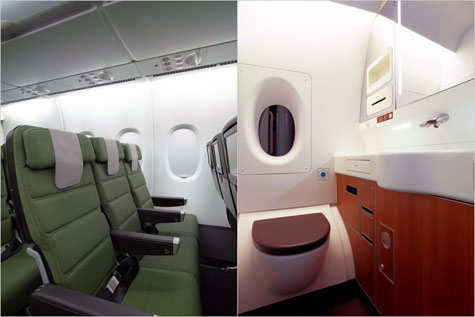 [Image: Airbus A380, photographed by Robyn Beck/Agence France-Presse for Getty Images, via the New York Times].
[Image: Airbus A380, photographed by Robyn Beck/Agence France-Presse for Getty Images, via the New York Times].Marc Newson's "retro-futurist" interior design for the new A380 super-jumbo airplane, to be run by Qantas, was the subject of an interesting article in the New York Times writes this morning.
Newson's "design language" for the airplane, we read, "is defined less by what the passengers see than by how they feel." One example of this is "the L.E.D.’s that illuminate the cabin":
They are programmed to wash the interior with colors that change subtly throughout the flight. Each shade is selected to create the ideal mood for a particular activity, like sleeping, waking or eating, regardless of time zone.Reading this instantly brought to mind a few things – including, somewhat obviously, the idea of the Gesamtkunstwerk, or total work of art, here transformed into a total environment sent aloft into the sky. Perhaps equally unsurprising, I was also reminded of Norman Foster's infamous choice of the Boeing 747 as his favorite building of the 20th century.
“Designing an aircraft is like creating a mini-world,” Mr. Newson said. “You’re putting people in a confined environment and controlling how they’ll feel with the oxygen, humidity and everything they touch and see. It all has an effect.”
Are airplanes the future of architecture, after all?
Somewhat more obscurely, however, I thought of the dream academy of Konstantin Melnikov – Melnikov's so-called "Sonata of Sleep." As the Winter 2007/2008 issue of Cabinet magazine described Melnikov's bizarre architectural invention:
At either end of the long buildings were to be situated control booths, where technicians would command instruments to regulate the temperature, humidity, and air pressure, as well as to waft salubrious scents and "rarefied condensed air" through the halls. Nor would sound be left unorganized. Specialists working "according to scientific facts" would transmit from the control centre a range of sounds gauged to intensify the process of slumber. The rustle of leaves, the cooing of nightingales, or the soft murmur of waves would instantly relax the most overwrought veteran of the metropolis. Should these fail, the mechanized beds would then begin gently to rock until consciousness was lost.In many ways, this Willy Wonka-like vision of synaesthetic architecture could be realized in the guise of international airplane travel, Newson inadvertently suggests. Lulled by strange colored lights and slowly changing sounds, passengers can be sent to sleep – or woken up – at the will of the pilot, who assumes a new, psychotropic role. It's an Esalen Institute in the sky.
 [Images: Photos by Brett Boardman, for the New York Times].
[Images: Photos by Brett Boardman, for the New York Times].A few brief questions:
1) What would an airplane designed by Jonathan Ive look like? Or if Mies van der Rohe had been hired to rethink the internal spaces of American Airlines? I feel like entire, speculative, university-level design courses could be organized around such lines of thought; they could be sponsored by Richard Branson. So does Newson's success – or, who knows, failure – in designing the Qantas A380 imply that our era needs a new Raymond Loewy? Or will climate change and high oil prices ultimately extinguish this temporary airborne niche in the field of architectural design?
2) Less relevantly, should airports look like the airplanes that depart from them? You walk from one tubular environment into another, and you sit in identical seats, served by similarly uniformed stewards – only the room you're now in suddenly accelerates, taking you up into the sky... Perhaps the interior design of airports and airplanes should be unified – made continuous – so, after too many drinks one night, waiting to depart from Dallas-Ft. Worth, you realize that you might be sitting in the airplane already... You demand to get off; hijinks ensue.
3) What were the test-environments for this airplane like? Did Newson have entire fake airplane hulls constructed somewhere, inside of which entire fake rooms and galleys could be installed – and what was it like to spend time inside that simulated airplane of the future?
4) Could you purchase one of Newson's perfectly molded bathrooms, receive it by delivery a week later, and then hook it up somewhere inside your own grounded house? I remember hearing once that the Spice Girls liked the mattresses that they slept on so much when they came through Philadelphia and stayed in the Four Seasons they that they simply bought the beds upon check-out. So could you fill out a form at the end of your trans-Pacific, San Francisco-Sydney flight, and say, sure, I'll buy two bathrooms and a couchette... deliver them to my house in Marin County? A whole subsidiary industry begins: you send experimental interiors into the skies of the world, aboard international business flights, hoping to sell a few rooms to your well-served, half-drunk passengers. What would happen if you could buy rooms from inside any building you've ever visited? Surely every interior could be given a price tag?
No comments:
Post a Comment